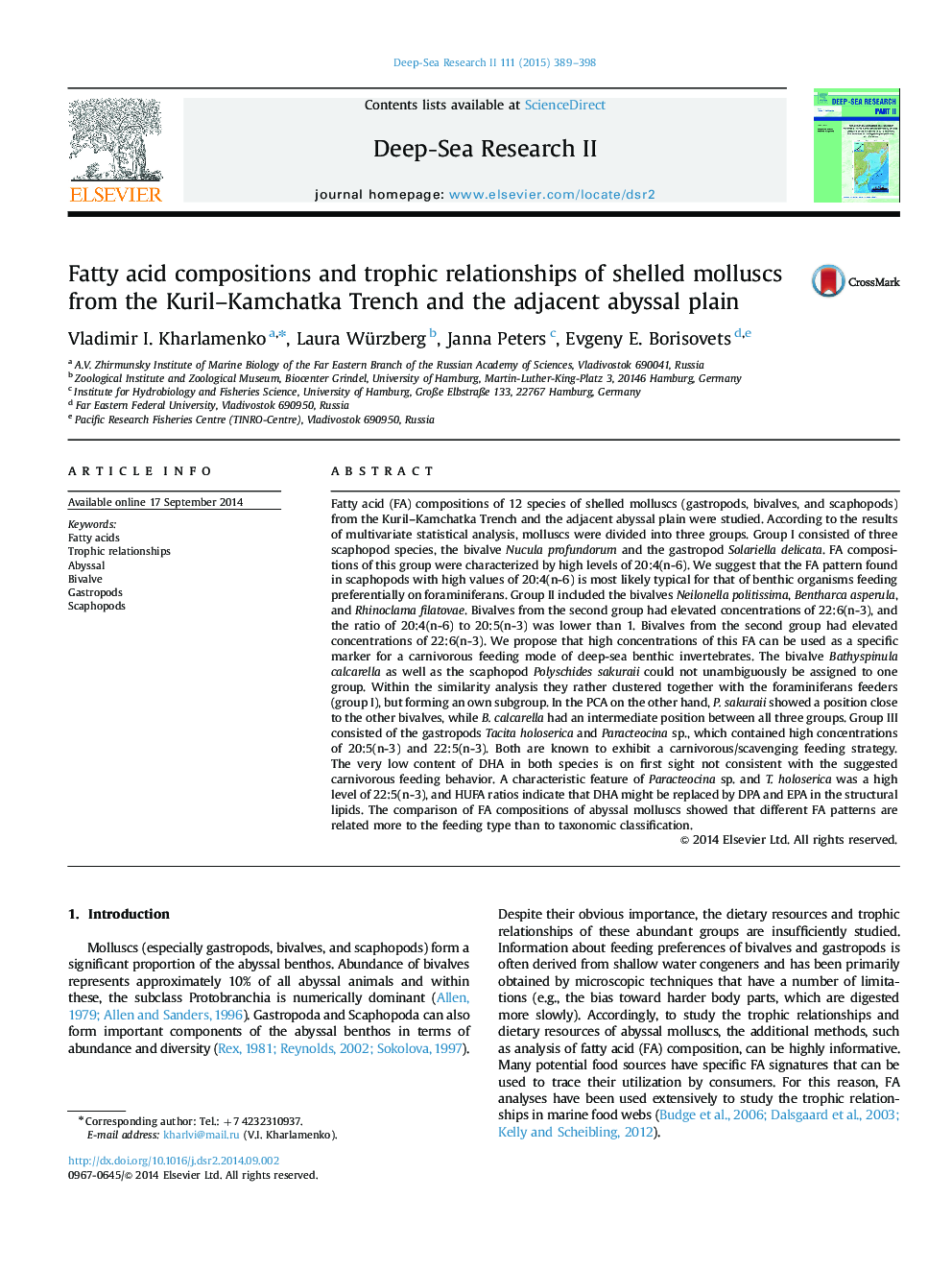| کد مقاله | کد نشریه | سال انتشار | مقاله انگلیسی | نسخه تمام متن |
|---|---|---|---|---|
| 4536305 | 1626429 | 2015 | 10 صفحه PDF | دانلود رایگان |
عنوان انگلیسی مقاله ISI
Fatty acid compositions and trophic relationships of shelled molluscs from the Kuril-Kamchatka Trench and the adjacent abyssal plain
ترجمه فارسی عنوان
ترکیبات اسید چرب و ارتباطات طوفان مولکول های شل شده از حوض کوریل کامچاتکا و دشت دریای مجاور
دانلود مقاله + سفارش ترجمه
دانلود مقاله ISI انگلیسی
رایگان برای ایرانیان
کلمات کلیدی
موضوعات مرتبط
مهندسی و علوم پایه
علوم زمین و سیارات
زمین شناسی
چکیده انگلیسی
Fatty acid (FA) compositions of 12 species of shelled molluscs (gastropods, bivalves, and scaphopods) from the Kuril-Kamchatka Trench and the adjacent abyssal plain were studied. According to the results of multivariate statistical analysis, molluscs were divided into three groups. Group I consisted of three scaphopod species, the bivalve Nucula profundorum and the gastropod Solariella delicata. FA compositions of this group were characterized by high levels of 20:4(n-6). We suggest that the FA pattern found in scaphopods with high values of 20:4(n-6) is most likely typical for that of benthic organisms feeding preferentially on foraminiferans. Group II included the bivalves Neilonella politissima, Bentharca asperula, and Rhinoclama filatovae. Bivalves from the second group had elevated concentrations of 22:6(n-3), and the ratio of 20:4(n-6) to 20:5(n-3) was lower than 1. Bivalves from the second group had elevated concentrations of 22:6(n-3). We propose that high concentrations of this FA can be used as a specific marker for a carnivorous feeding mode of deep-sea benthic invertebrates. The bivalve Bathyspinula calcarella as well as the scaphopod Polyschides sakuraii could not unambiguously be assigned to one group. Within the similarity analysis they rather clustered together with the foraminiferans feeders (group I), but forming an own subgroup. In the PCA on the other hand, P. sakuraii showed a position close to the other bivalves, while B. calcarella had an intermediate position between all three groups. Group III consisted of the gastropods Tacita holoserica and Paracteocina sp., which contained high concentrations of 20:5(n-3) and 22:5(n-3). Both are known to exhibit a carnivorous/scavenging feeding strategy. The very low content of DHA in both species is on first sight not consistent with the suggested carnivorous feeding behavior. A characteristic feature of Paracteocina sp. and T. holoserica was a high level of 22:5(n-3), and HUFA ratios indicate that DHA might be replaced by DPA and EPA in the structural lipids. The comparison of FA compositions of abyssal molluscs showed that different FA patterns are related more to the feeding type than to taxonomic classification.
ناشر
Database: Elsevier - ScienceDirect (ساینس دایرکت)
Journal: Deep Sea Research Part II: Topical Studies in Oceanography - Volume 111, January 2015, Pages 389-398
Journal: Deep Sea Research Part II: Topical Studies in Oceanography - Volume 111, January 2015, Pages 389-398
نویسندگان
Vladimir I. Kharlamenko, Laura Würzberg, Janna Peters, Evgeny E. Borisovets,
